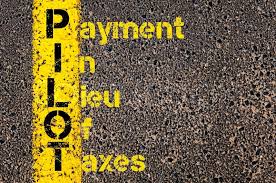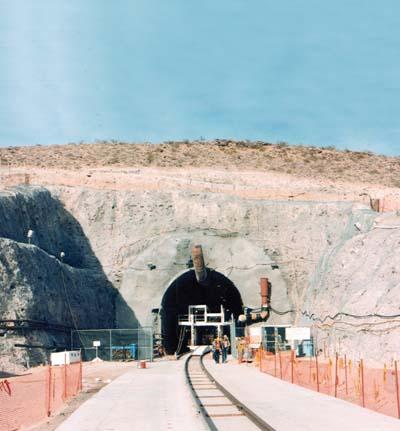|
|
|
|
|
|
|
|
|
|
Updates from the SRSCRO
|
July 2017
|
|
Follow us on Twitter!
|
Rick McLeod @atomicasset

|
Mindy Mets @nuclearstem

|
|
|
|
|
|
|
What is a "PILT"
 The Atomic Energy Act of 1946, as amended, authorized the then Atomic Energy Commission (AEC) to compensate communities for the loss of tax revenues on properties used for its purposes in cases in which the properties had been removed from the local tax rolls. Such compensation is termed "payments in lieu of taxes" or "PILT" because federally owned property is not subject to state and local taxation. The act also authorized AEC to make payments in excess of the taxes if a community experienced "special burdens" as a result of AEC'S activities. Subsequent legislation transferred these authorities to ERDA and DOE.
The act specifies that these payments may be in the amounts, at the times, and upon the terms that AEC and its successors deem appropriate. However, the payments generally cannot exceed the amount of taxes that would have been payable for the property "in the condition in which it was acquired." DOE and its predecessors have interpreted this statement to mean that if the property was used for agricultural purposes when acquired, the payments must be based on the property's value as agricultural property rather than, for example, its value as industrial or commercial property, although the latter categories may more closely reflect the property's current use.
The Act gives the Secretary of Energy broad authority in making PILT payments. The amounts, the timing, and the terms of the payments are at the discretion of the Secretary. The formulas used by DOE to determine what payments it will make are not transparent, and are not interpreted consistently across all sites.
In a recent Committee Report in the House Energy and Water Bill, PILT payments are under scrutiny. Language in the Committee Report appears to advocate for the termination of all of the current PILT agreements and require new agreements. "DOE shall terminate all existing PILT agreements and enter into new PILT agreements that are consistent across all eligible sites and are in compliance with the requirement that payments are not made in excess of the taxes that would have been payable for such property in the condition in which it was originally acquired."
The full conference report can be reviewed
here.
While this issue is not by any means final, it does warrant considerable vigilance on our part. If the movement does move forward, the potential impact to our local area is significant. As a refresher, the percent of acres that SRS comprises per South Carolina are as follow:
* Barnwell County -- 63%
* Aiken County -- 35%
* Allendale County -- 2%
The FY 2017 PILT payment for the three counties totaled $6,475,376 and is broken down by county as provided below:
* Barnwell County -- $4,765,868
* Aiken County -- $1,620,000
* Allendale County -- $89,508
|
Summertime TREAT
 A Skilled Nuclear Workforce of the Future was one of the many subjects covered at the 2017 Summer TREAT workshop for educators during July. This overview of future nuclear workforce needs was provided by the SRSCRO's Nuclear Workforce Initiative (NWI®) and included messages that employers say they hope educators will share with their students about the importance of safety and soft skills. Other topics covered in this segment of the workshop included: nuclear career options, local training opportunities, scholarship programs and future nuclear workforce needs. A Skilled Nuclear Workforce of the Future was one of the many subjects covered at the 2017 Summer TREAT workshop for educators during July. This overview of future nuclear workforce needs was provided by the SRSCRO's Nuclear Workforce Initiative (NWI®) and included messages that employers say they hope educators will share with their students about the importance of safety and soft skills. Other topics covered in this segment of the workshop included: nuclear career options, local training opportunities, scholarship programs and future nuclear workforce needs.
 More than 30 local middle and high school educators attended the TREAT Workshop, held on the campus of the University of South Carolina Aiken, to learn about
Teaching
Radiation
Energy
And
Technology. The annual program is funded by a grant from the U. S. Department of Energy (DOE) on Environmental Radiation and Community Awareness. Instructors included Dr. Kenneth S. Sajwan, Professor and Director of the Environmental Science Program, Savannah State University; and representatives from the Savannah River Site, the Environmental Protection Agency, and the South Carolina Department of Health and Environmental Control. DOE student interns also attended the three-day workshop to learn about the role of multiple organizations at the Savannah River Site such as the USDA Forest Service, the Citizens Advisory Board and Emergency Response Management. Attendees had the opportunity to tour SRS as part of the workshop.
The community outreach activity is in its 22nd year of working to educate kindergarten through 12th grade mathematics and science teachers and local community leaders who reside near the DOE's Savannah River Site facility about related topics. For more information about TREAT Workshops, contact
[email protected].
|
It's Back.....Maybe....Yucca Schizophrenia
 The U.S. House of Representatives Appropriations Committee recently advanced a fiscal 2018 spending bill for energy and water development that includes funding for the Yucca Mountain nuclear waste repository. It provides $90 million for the nuclear waste disposal program, $30 million for defense nuclear waste disposal and $30 million to resume the process for the Yucca Mountain license application. According to Rep. Mike Simpson (R-ID), Chairman of the environment subcommittee, "The bill sends a clear message that it is time to address the long-term storage of spent nuclear fuel and finish the Yucca Mountain license application."
Back in June, Energy Secretary Rick Perry told the House Appropriations subcommittee that the government has a "moral obligation" to revive the stalled Yucca Mountain nuclear waste repository and suggested that unlike other programs on the financial chopping block, the Trump administration is committed to the project. He said one of his top priorities is to open Yucca and use it as a landing spot for the roughly 77,000 tons of used nuclear fuel currently stored across the country. Secretary Perry said, "We have a moral and national security obligation to come up with a long-term solution, finding the safest repositories available. I understand this is a politically sensitive topic for some, but we can no longer kick the can down the road."
However, a Senate subcommittee on July 18 advanced legislation without including funding for Yucca Mountain in it. The bill that cleared the Senate's Energy and Water Appropriations subcommittee Tuesday did not include $120 million in funding the Department of Energy requested for Yucca Mountain. Senator Dean Heller from Nevada called the action a positive step in the long fight to ensure Yucca Mountain remains dead. It has been widely reported that the senator is in the midst of a very tough re-election bid. So, right now Yucca Mountain gets diagnosed with political schizophrenia.
|
|
|
|
Spotlight
STEM Premier

STEM Premier is an online platform connecting the next generation of talent with colleges and companies across the country. Students (age 13+) join and create a digital profile showcasing their skills, talents, and accomplishments, career interests, next steps, and more. From there, they can share their profile, link up with mentors, and be seen by 200+ (and growing) colleges, companies, and organizations who can direct message them to start a conversation.
It's all about engaging earlier and building a future talent pipeline. We help colleges and companies establish a connection with a younger audience, create brand awareness, and build an invaluable rapport with emerging talent - no matter where you are.
Learn more at
www.stempremier.com
|
|
2017
Total Solar Eclipse
Fun Facts

1. The August 21, 2017, total solar eclipse will be the first one in the continental U.S. in 38 years. The last one occurred February 26, 1979.
2. Everyone in the continental U.S. will see at least a partial eclipse. More than 10 million people are in the path of totality and 28 million people live within 60 miles of the path.
3. This eclipse will cross only the U.S. and no other country.
4. State Capitals in the path: Salem, OR (pop. of 157,000); Jefferson City, MO (pop. of 43,000); Nashville, TN (pop. of 609,000); and Columbia, SC (pop. of 132,000)
5. It is never safe to look at the Sun without proper eye protection. The only safe way to view a partial or annular eclipse is using a projection of the Sun (such as a pinhole projector). Filtered views of the Sun (such as eclipse glasses) can be safe too but the equipment must be properly filtered and correctly used.
6. During the time the Moon's disk covers that of the Sun, it's safe to look at the eclipse. In fact, to experience the awesomeness of the event, you must look at the Sun without a filter during totality.
7. You won't need a telescope. One of the great things about the total phase of a solar eclipse is that it looks best to naked eyes. The sight of the corona surrounding the Moon's black disk in a darkened sky is unforgettable.
8. You may experience strange things. Apparent nightfall, dusk to dawn lights may come on. Shadows will look eerie. Breezes may vanish and birds may come in to roost. A 10°-15° F drop in temperature is not unusual.
9. Canadian astronomer and renowned eclipse chaser J. W. Campbell traveled the world for 50 years trying to see 12 different eclipses. He ran into overcast skies every time.
10. The shadow of the Moon will hurtle across the United States at supersonic speeds (2,400 mph), and cross more than 2,400 miles from just north of Newport, Ore., to just beyond McClellanville, S.C. in about 90 minutes.
|
|
MORE About
The Great American Solar Eclipse 2017
For more information about the eclipse, the DuPont Planetarium at Ruth Patrick Science Education Center at USC Aiken has information online, including viewing times, viewing locations, and where to
get your Eclipse Viewers so that you can observe the eclipse safely. Click
here to find the website.
|
|
|
|
Closing Thoughts
|
|
"There are painters who transform the sun to a yellow spot, but there are others who with the help of their art and their intelligence transform a yellow spot into the sun." --
Pablo Picasso
"Skeptical scrutiny is the means, in both science and religion, by which deep insights can be winnowed from deep nonsense." --
Carl Sagan
"There is something fascinating about science. One gets such wholesale returns of conjecture out of such a trifling investment of fact." --
Mark Twain
"No one means all he says, and yet very few say all they mean, for words are slippery and thought is viscous." --
Henry Adams
"You can observe a lot just by watching." --
Yogi Berra
|
|
Contact Information
|
SRSCRO, PO Box 696, Aiken, SC 29802

Staff:
Rick McLeod - President/CEO - 803-508-7402
Mindy Mets - NWI® Program Manager - 803-508-7403
Amy Merry - Administrative & Business Manager - 803-508-7401
Kim Saxon - Assistant Coordinator - 803-508-7656
|
|
| |
|